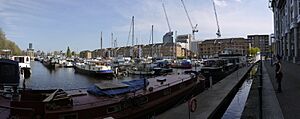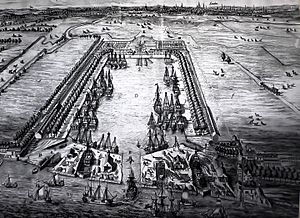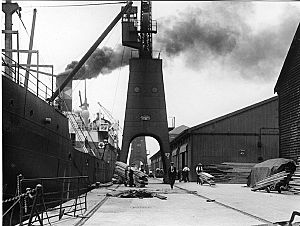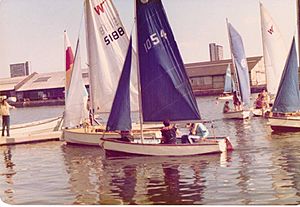Greenland Dock facts for kids
Greenland Dock is the oldest dock in London that's right by the River Thames. It's located in an area called Rotherhithe, which is part of Docklands. This dock used to be a busy place for ships, but now it's mainly used for fun activities like watersports. It's one of only two docks still working on the south side of the Thames. It's connected to South Dock by a small channel called Greenland Cut.
Contents
History of Greenland Dock
The First Dock: Howland Great Wet Dock
Greenland Dock was first built between 1695 and 1699. It was on land owned by a rich family called the Russells. They got this land as a wedding gift. The family decided to build a large dock there.
In 1695, they got permission to build a rectangular dock. It was about 10 acres (4.0 ha) big and could hold around 120 ships. They named it Howland Great Wet Dock after John Howland, who had owned the land. A local shipbuilder named John Wells designed it. The dock was meant for repairing and preparing ships, especially those from the East India Company.
Around 1717, the dock was in a countryside area, far from the small city of London. It had trees around it to block the wind. The Russell family's house was at one end. This first dock wasn't built for loading and unloading goods. Instead, it was a safe place for ships to be fixed and kept. It was also close to other shipyards in Deptford.
Whaling and Timber Trade
Starting in the 1720s, ships that hunted Greenland whales began to use the dock. Large buildings were put up to boil whale blubber and make oil. In 1763, the dock was sold and renamed Greenland Dock because of all the whaling ships. However, whaling stopped being popular by the early 1800s.
In 1806, William Richie, a timber merchant, bought the dock. He started the Commercial Dock Company. This company built more docks and two new ponds for storing timber. Other companies also built docks nearby. This led to many different docks, canals, and timber ponds all mixed together. In 1865, these companies joined to form the Surrey Commercial Docks. This new company controlled about 80% of London's timber trade.
Greenland Dock stayed important for London's timber trade for over 100 years. It had many warehouses and huge piles of wood. Special workers called "deal porters" moved this wood. Much of the timber came from the Baltic region on small sailing ships. Later, large steamships took over this job.
Growth and End of an Era
Between 1895 and 1904, Greenland Dock was made much bigger. This big project cost a lot of money. It was led by Sir John Wolfe Barry, who also built Tower Bridge. The dock more than doubled in length and almost doubled in depth. In its final form, it was 22+1⁄2 acres (9.1 ha) big, 31 feet (9.4 m) deep, and 2,250 feet (690 m) long. It even cut across an old canal.
A very large lock was also added. It was 550 feet (170 m) long, 80 feet (24 m) wide, and 35 feet (11 m) deep. This made it possible for huge cargo ships and even ocean liners to use the dock. Large Cunard Line ships, weighing up to 14,000 long tons (14,000 t), sailed regularly from Greenland Dock to Canada. These were considered very big ships to go so far up the river.
In 1909, Greenland Dock and all other London docks came under the control of the Port of London Authority.
Even with the big steamships, smaller sailing ships called barques still brought timber from Finland. These ships, with three or more masts, were a reminder of the older timber trade from the Baltic Sea. Some areas around the dock were named after these countries, like Finland Quay and Norway Dock.
Greenland Dock was badly damaged during World War II. Many warehouses were destroyed by bombs, and the large lock was broken. The dock recovered after the war and was busy again for a short time. However, new shipping methods soon caused the dock to decline. From 1958, timber started to be packaged, and the jobs of the deal porters ended. Soon after, the shipping industry switched to containerization. This meant ships were too large for the London docks. In 1970, the Surrey Commercial Docks, including Greenland Dock, were closed. Greenland Dock was then sold to the local council.
Redevelopment of the Docklands
After the docks closed, the area was empty for over ten years. Most of the warehouses were pulled down, and over 90% of the docks were filled in. Greenland Dock was saved from this fate. In 1981, it was given to the London Docklands Development Corporation. During this time, a watersports center was set up at the dock. Many young people learned to sail or canoe there.
A plan was made to turn the dock into a place for homes. This happened in the late 1980s. Seven new housing areas were built where the old warehouses used to be. They were even named after the old warehouses, like Swedish Quay and Brunswick Quay. Today, the area has many modern homes.
A new watersports center was also built. This has kept the dock a popular place for sailing, windsurfing, canoeing, and dragon boat racing.
The dock itself is still mostly the same, except for its old entrances and exits, which are now filled in or blocked. It still connects to South Dock, which is now a marina. Greenland Dock also has a small marina at its eastern end. There are no signs of the old warehouses, but some old capstans (machines used to pull ropes) and hydraulic machines on the quayside have been kept.
Transport
The closest London Underground station is Canada Water on the Jubilee line. The closest London Overground stations are Surrey Quays and Canada Water.
Thames Clippers' water-bus stops at Greenland Pier. The Thames Path walking route goes along the southern bank of the River Thames.
Nearby Places
- Canada Water
- Russia Dock Woodland
- South Dock
- Surrey Quays







